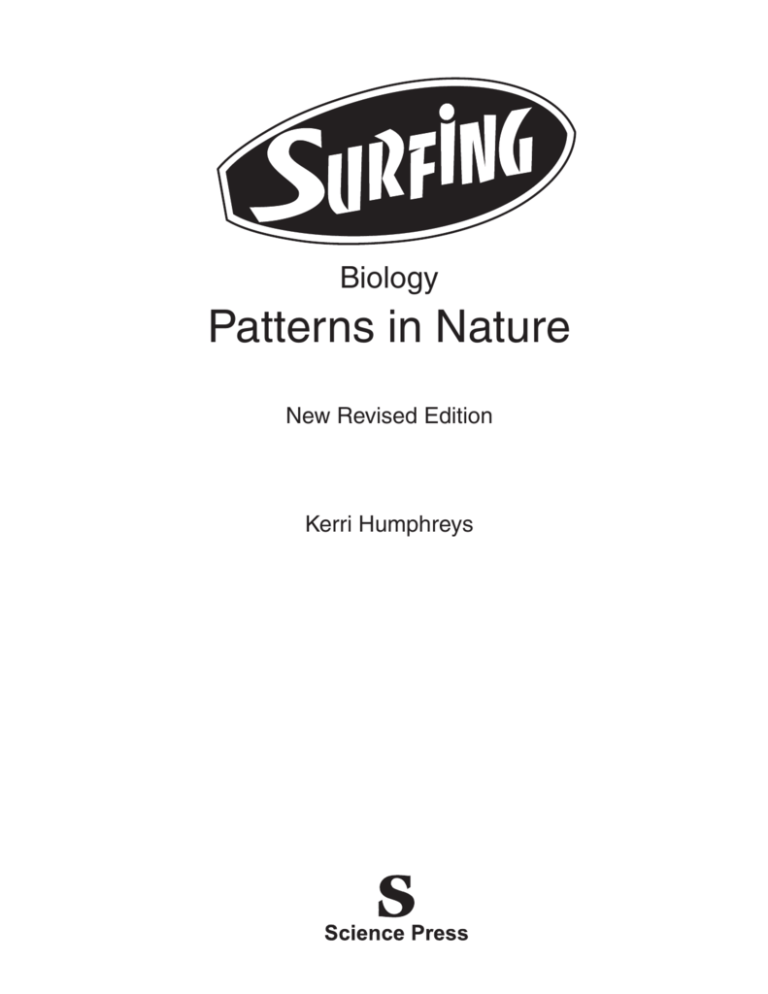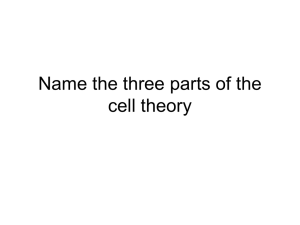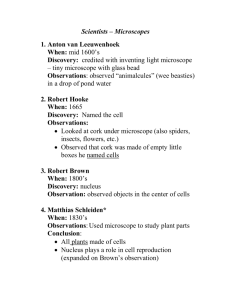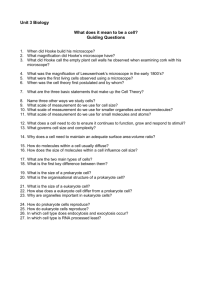
Biology
Patterns in Nature
New Revised Edition
Kerri Humphreys
Contents
Use the table of contents to record your progress through this book. As you complete each topic, write the date
completed, then tick one of the three remaining columns to guide your revision for later. The column headers use
the following codes:
?? = Don’t understand this very well at all.
RR = Need to revise this.
OK = Know this.
Topic
Page
Date
done
??
RR OK
Topic
Page
Introduction
1
25 Experiment – Surface Area to
Volume Ratio and Diffusion
28
Verbs To Watch
1
26 Experiment – Plasmolysis
30
1
Assumed Knowledge
2
27 Human Organ Systems
31
2
Cell Theory and Robert Hooke
3
28 Plant Organs
32
3
Cell Theory and Robert Brown
4
29Photosynthesis
34
4
Historical Development of Cell
Theory
5
30 Play – Inside Photosynthesis
35
5
The Modern Light Microscope
6
31 Experiment – Chlorophyll and
Photosynthesis
39
6
The Electron Micorscope
7
32 Experiment – Light and
Photosynthesis
40
7
Cells, Tissues, Organs and Systems
8
33 Experiment – Surface Area and
Rate of Reaction
41
8
Experiment – The Light Microscope
9
34 Root Structure
42
9
Experiment – Using a Light
Microscope
10
35Leaves
43
10 Experiment – Making a Wet Mount
11
36Teeth
45
11 Experiment – Drawing Biological
Diagrams
12
37 Digestive Systems
47
12 The Light Microscope and Cell
Organelles
13
38 Play – Amino and Lipidet, A Most
Lamentable Tragedy
49
13 Experiment – Plant Cells
15
39 Carnivore, Herbivore and Nectar
Feeder Digestive Systems
54
14 Experiment – Animal Cells
16
40 Respiratory Systems
56
15 The Electron Microscope and Cell
Organelles
17
41 Experiment – Transpiration
59
16Mitochondria
18
42 Transport Systems in Plants
61
17Chloroplasts
19
43Stomates
64
18 Golgi Bodies
20
44 Experiment – Movement in Xylem
66
19 Chemicals in Cells
21
45 Circulatory Systems in Animals
67
20 Experiment – Substances in Tissues
23
46Radioisotopes
69
21 The Cell Membrane
24
47Mitosis
70
22 Diffusion and Osmosis
25
72
23 Active Transport
26
Answers
24 Experiment – Membranes,
Diffusion and Osmosis
27
© Science Press 2011
First published 2004
Revised Edition 2011
Science Press
Bag 7023 Marrickville NSW 1475 Australia
Tel: (02) 9516 1122 Fax: (02) 9550 1915
sales@sciencepress.com.au
www.sciencepress.com.au
Topic Test
Date
done
??
RR OK
75
All rights reserved. No part of this publication
may be reproduced, stored in a retrieval system,
or transmitted in any form or by any means,
electronic, mechanical, photocopying, recording
or otherwise, without the prior permission of
Science Press. ABN 98 000 073 861
construct
Make, build, put together items or
arguments.
contrast
Show how things are different or
opposite.
critically (analyse/evaluate) Add a degree or level
of accuracy, depth, knowledge and
under­standing, logic, questioning,
reflection and quality to an
analysis or evaluation.
deduce
Draw conclusions.
define
State the meaning of and identify
essential qualities.
demonstrate Show by example.
describe
Provide characteristics and
features.
discuss
Identify issues and provide points
for and against.
distinguish
Recognise or note/indicate as
being distinct or different from,
note difference between things.
evaluate
Make a judgement based on
criteria.
examine
Inquire into.
explain
Relate cause and effect, make
the relationship between things
evident, provide why and/or how.
extract
Choose relevant and/or appropriate
details.
extrapolate Infer from what is known.
identify
Recognise and name.
interpret
Draw meaning from.
investigate
Plan, inquire into and draw
conclusions about.
justify
Support an argument or
conclusion.
outline
Sketch in general terms; indicate
the main features.
predict
Suggest what may happen based
on available information.
propose
Put forward a point of view, idea,
argument, suggestion etc for
consid­eration or action.
recall
Present remembered ideas, facts or
experiences.
recommend Provide reasons in favour.
recount
Retell a series of events.
summarise
Express concisely the relevant
details.
synthesise
Put together various elements to
make a whole.
Introduction
Each book in the Surfing series contains a summary,
with occasional more detailed sections, of all the
mandatory sections of the syllabus, along with questions
and answers.
It is envisaged this book will be useful in class for
both initial understanding and revision, while the more
traditional textbook can remain at home for more
detailed analysis.
All types of questions – multiple choice, short response,
structured response and free response – are provided.
Questions are written in exam style and use the verbs
specified by the Board of Studies so that you will
become familiar with the concepts of the topic and
answering questions in the required way.
Answers to all questions are included.
A topic test at the end of the book contains an extensive
set of summary questions, including multiple choice and
free response questions. These cover every aspect of
the topic, and are useful for revision and exam practice.
Marking guidelines are supplied where appropriate.
Verbs To Watch
account, account for State reasons for, report on, give
an account of, narrate a series of
events or transactions.
analyse
Identify components and the
relation­ships among them, draw
out and relate implications.
apply
Use, utilise, employ in a particular
situation.
appreciate
Make a judgement about the value
of something.
assess
Make a judgement of value,
quality, outcomes, results or size.
calculate
Determine from given facts,
figures or information.
clarify
Make clear or plain.
classify
Arrange into classes, groups or
categories.
compare
Show how things are similar or
different.
Science Press
Surfing Biology
1
Patterns in Nature
1
Assumed Knowledge
A
1.
2.
3.
Draw a fully labelled diagram of a plant cell as
seen under a light microscope.
Draw a fully labelled diagram of an animal cell as
seen under a light microscope.
Identify the following parts of a light microscope.
B
C
D
E
F
A
B
G
H
I
J
C
E
F
Figure 1.1
4.
Describe one safety precaution you should follow
while using a light microscope.
What is photosynthesis?
Which group of organisms can photosynthesise?
Identify the materials required by multicellular
organisms for photosynthesis.
Why is photosynthesis an important process in
ecosystems?
What is the function of the digestive system?
Figure 1.2 shows the human digestive tract.
Identify each part.
For each of the following parts of the digestive
system, outline its structure and its main function.
(a)Mouth.
(b)Oesophagus.
(c)Stomach.
(d) Small intestine.
(e) Large intestine.
(f)Anus.
Define respiration.
In humans, what structures make up the respiratory
system?
Outline the function of the respiratory system.
Outline the function of the circulatory system.
5.
6.
7.
8.
9.
10.
11.
12.
13.
14.
15.
Patterns in Nature
Human digestive tract.
16. In humans, what is the function of the heart in the
circulatory system?
17. Identify the components of the human circulatory
system.
18. In plants, what is the function of each of the
following?
(a)Xylem.
(b)Phloem.
(c)Leaves.
(d)Roots.
19. What is transpiration?
20. Study the flow chart below.
D
Figure 1.2
Light microscope.
Mature cell
‘parent’
(Division)
Small cell
‘daughter’
Small cell
‘daughter’
(Increase in size)
(Increase in size)
Mature cell
Mature cell
Figure 1.3
Division of a cell.
21.
22.
23.
What type of division is indicated by this chart?
Define mitosis.
Explain why cell division is important.
How is genetic information transferred during cell
reproduction?
24. Define a gene.
25. Define cytokinesis.
2
Science Press
Surfing Biology
2
In 1678 Anton van Leeuwenhoek (1632-1723) reported
the presence of ‘little animals’ in lake water. The Royal
Society of London asked Robert Hooke to investigate these
findings and when he confirmed the presence of small
organisms, Leeuwenhoek’s work was accepted.
Cell Theory and Robert Hooke
Robert Hooke (1635-1703) was an experimental
scientist who was interested in physics, astronomy,
chemistry, biology, geology, architecture and naval
technology, although his primary interest was
microscopy, mechanics and instrumentation.
He invented a compound light microscope, i.e. a
microscope with more than one lens, and observed many
organisms under this microscope. He also developed a
micrometer; the universal, or Hooke’s joint found in all
cars; the spring control of the balance wheel in watches;
the first reflecting telescope and was involved in creating
different types of barometers.
(a) Drawing(a)
of drawing
a flea.
of a flea
(b) drawing of a slice of
(b) Drawing of a slice of cork.
(a) drawing of a flea
(b) drawing of a slice of cork
Figure 2.2 Drawings by Robert Hooke from his book
Micrographic.
Figure 2.1
Hooke’s microscope.
For You To Do
Robert Boyle was Hooke’s patron when Hooke began
studying at Oxford. However, Hooke clashed with Isaac
Newton and this may have affected his fame in history.
His first publication was printed in 1661 and was a
pamphlet on capillary action. In 1665, he published a
book, Micrographic, which contained many drawings
and records of his observations under the microscope. It
also included a theory of light.
1.
2.
3.
4.
5.
When Hooke observed a slice of cork under his
microscope he discovered plant cells. He coined the
term ‘cells’ to describe what he saw.
6.
‘Yet it was not unlike a honeycomb in these
particulars … these pores, or cells, … consisted of a
great many little boxes.’
He also put fossils under his microscope and observed
the similarities of fossil shells with living mollusc shells.
Science Press
Surfing Biology
3
Name two instruments invented by Robert Hooke.
What is meant by a ‘compound’ microscope?
Discuss the significance of the invention of the
compound microscope.
How did the term ‘cell’ originate as used in
biology?
Robert Hooke observed a honeycomb appearance
under the microscope which he called ‘cells’. What
was he actually viewing?
Who was the first person to describe microbes in
water under a microscope?
(A)Hooke.
(B)Leeuwenhoek.
(C)Brown.
(D)Newton.
Patterns in Nature









